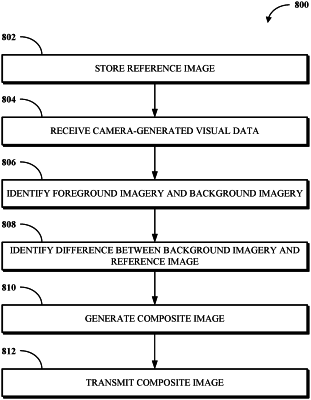| CPC H04N 7/147 (2013.01) [G06T 7/194 (2017.01); G06V 40/161 (2022.01); G06T 2207/10016 (2013.01); G06T 2207/30196 (2013.01)] | 20 Claims |

|
1. A method, comprising:
storing a reference image representing a physical background within a field of view of a camera of a client device;
receiving, via the camera and during a video conference to which the client device is connected, camera-generated visual data for output to at least one remote device connected to the video conference;
identifying, based on facial recognition applied to the camera-generated visual data, foreground imagery representing at least one person and background imagery representing content of the camera-generated visual data other than the foreground imagery;
identifying a difference between the background imagery and the reference image by identifying an item in the background imagery and determining that the item is not present at a co-located part of the reference image, the co-located part of the reference image being identified based on non-movable fixtures depicted in the background imagery and the reference image;
generating a composite image by replacing, within the background imagery of the camera-generated visual data, an item represented within the background imagery and within the identified difference with a co-located part of the reference image; and
transmitting the composite image to the at least one remote device during the video conference.
|
|
10. A non-transitory computer readable medium storing instructions operable to cause one or more processors to perform operations comprising:
storing a reference image representing a physical background within a field of view of a camera of a client device;
receiving, via the camera and during a video conference to which the client device is connected, camera-generated visual data for output to at least one remote device connected to the video conference;
identifying, based on facial recognition applied to the camera-generated visual data, foreground imagery representing at least one person and background imagery representing content of the camera-generated visual data other than the foreground imagery;
identifying a difference between the background imagery and the reference image by identifying an item in the background imagery and determining that the item is not present at a co-located part of the reference image, the co-located part of the reference image being identified based on non-movable fixtures depicted in the background imagery and the reference image;
generating a composite image by replacing, within the background imagery of the camera-generated visual data, an item represented within the background imagery and within the identified difference with a co-located part of the reference image; and
transmitting the composite image to the at least one remote device during the video conference.
|
|
19. An apparatus, comprising:
a memory; and
a processor configured to execute instructions stored in the memory to:
store a reference image representing a physical background within a field of view of a camera of a client device;
receive, via the camera and during a video conference to which the client device is connected, camera-generated visual data for output to at least one remote device connected to the video conference;
identify, based on facial recognition applied to the camera-generated visual data, foreground imagery representing at least one person and background imagery representing content of the camera-generated visual data other than the foreground imagery;
identify a difference between the background imagery and the reference image by identifying an item in the background imagery and determining that the item is not present at a co-located part of the reference image, the co-located part of the reference image being identified based on non-movable fixtures depicted in the background imagery and the reference image;
generate a composite image by replacing, within the background imagery of the camera-generated visual data, an item represented within the background imagery and within the identified difference with a co-located part of the reference image; and
transmit the composite image to the at least one remote device during the video conference.
|